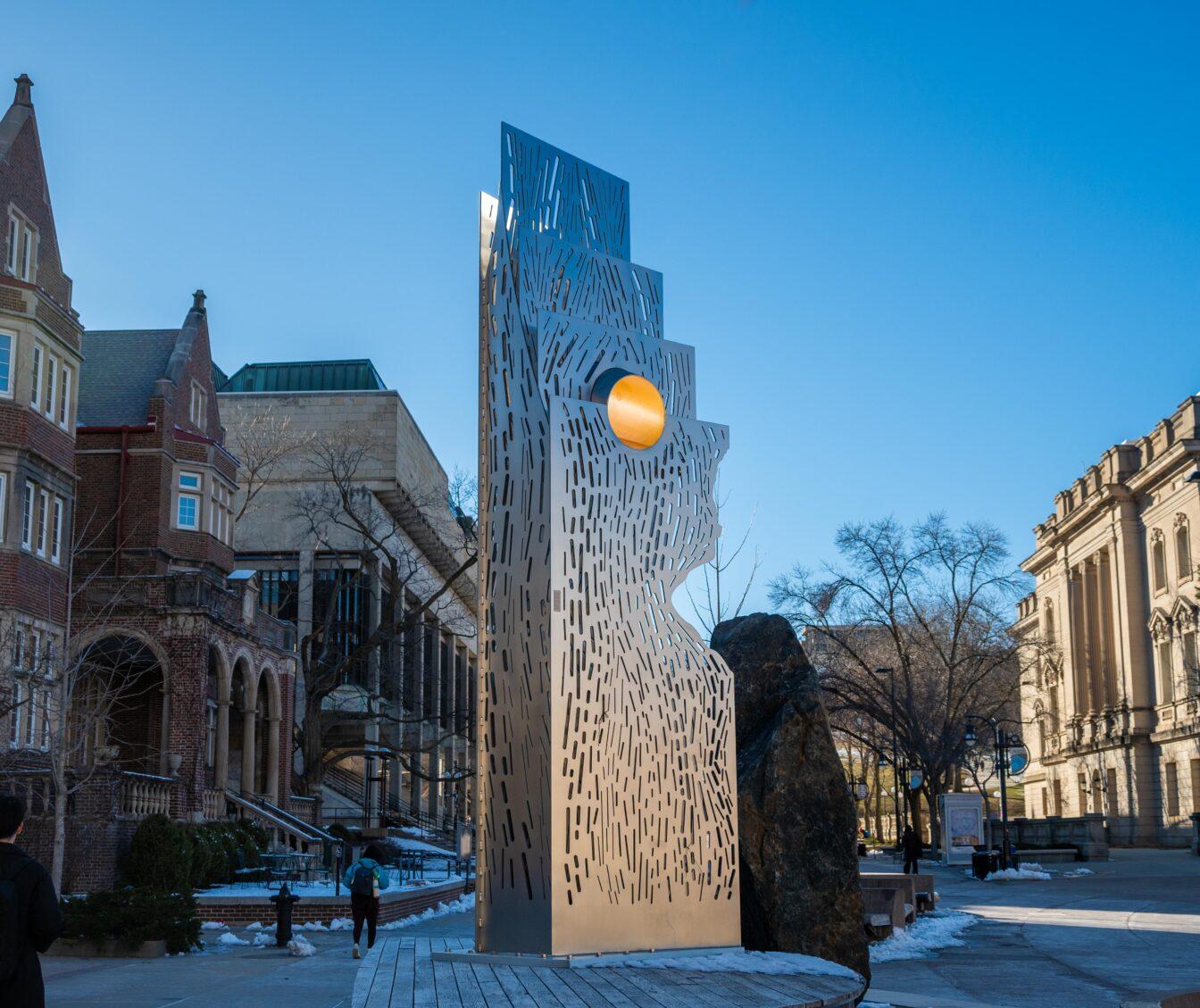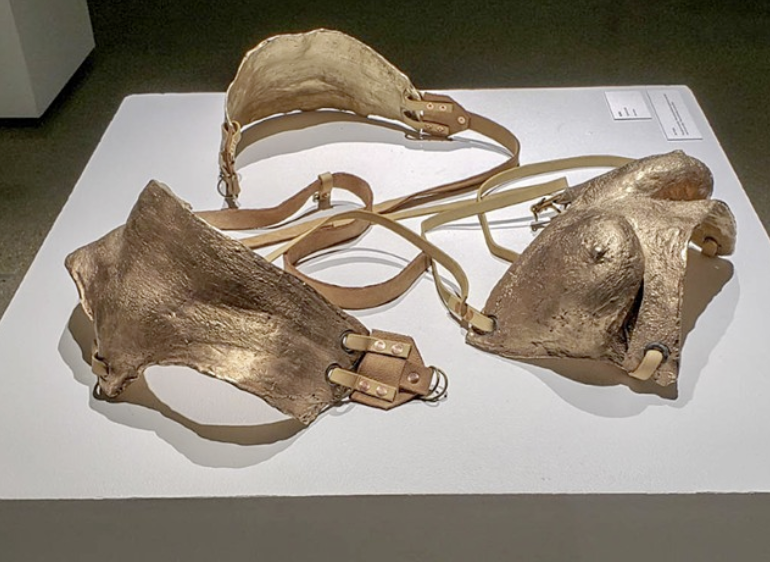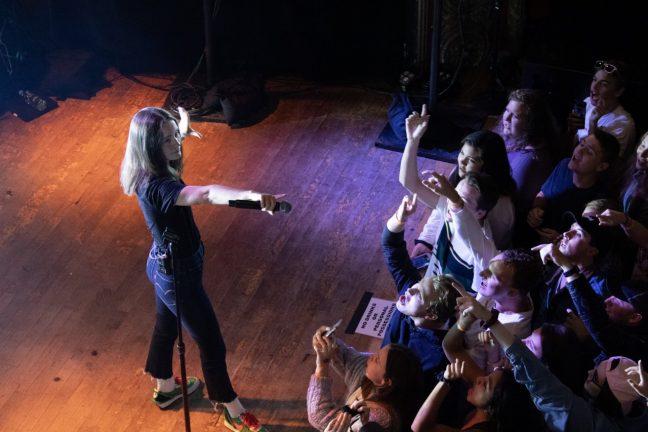
Today marked the opening of the Chazen Museum of Art’s other half. For the past two years, students have walked by another construction site. But today we welcome a new member to the university and Madison. The Chazen has doubled its size through an 86,000 square-foot extension. The project cost $43 million, an enormous community investment.
In the last month, newspapers and museum staff emphasized the links they see between “the old Chazen” and “the new Chazen,” as one docent described the buildings today. The bridge that connects the two buildings has become an icon. The Wisconsin State Journal called it a “bridg[e] of inspiration.” At today’s opening, the Chazen’s director Russell Panczenko characterized the bridge as a symbol of the Chazen’s connection to its own history and links to greater Madison.
“Behind that stone facade that you see from University Avenue there is an entire line of galleries,” Panczenko said today. “There is one continuous line” and a “real relationship between what you see on the outside of the building and on the inside of the building.” The buildings “will continuously mesh together,” a docent said.
Routinely, museum staff, docents and reporters draw analogy between the two halves of the Chazen, the city and the university; all four are somehow linked by the new bridge. However, when it comes to explaining how the Chazen will accomplish the tremendous goal of establishing these links through art, the bridge’s route becomes a bit twisty. The museum promotes this expansion as one that will double the experience, but for whom and how?
A major selling point for the expansion has been the opportunities the wing brings to Madison and the university. It gives city residents new opportunities to experience art. Most obvious are the artworks themselves. The Chazen is currently the proud holder of pieces by 20th century figureheads like Roy Lichtenstein, Jasper Johns and Pablo Picasso. Many of these are on lend from the private collections of Simona and Jerome Chazen (for whom the museum is named), so viewers should see them while they can.
Viewers may notice the new wing incorporates more glass into its ceiling and walls than the Elvehjem. Panczenko says this was intentional. He thinks that letting in some natural light helps humanize the museum experience.
“You will notice there are no white galleries in here. White galleries were in the philosophy of a laboratory sterile space,” he said. “You weren’t distracted from the art by anything. In our case, we don’t mind a little bit of distraction; that’s what real life is like.”
The Chazen’s design also reflects the staff’s desire to bring artwork “down to Earth.” In one case, literally. A corner of the third floor hides a seating area that could, out of context, be found in anyone’s living room. However, in this one rests a painting, “Pink Lady,” created by Wisconsin artist Robert Grilley. The museum artwork sits at chair level with visitors. Panczenko describes these “little places” as one way the museum “reduce[s] the formality of galleries.”
Another way the museum provides opportunities to Wisconsin residents is by giving them the chance to see Wisconsin artists represented in the collections. Panczenko talks of Milwaukee-born artist John Wilde’s contributions to magic realism, an important artistic style of the 1940s. Many works from this movement are found in one gallery.
Panczenko notes that the magic realists “came up with their own personal understanding of surrealism … It was not the literary surrealism of the East Coast and Europe, but it was their own version of it. They are a terribly important movement, and we’ve been very fortunate to acquire their art.”
Viewers’ chance to witness Wisconsin contributions to American cultural history is one important aspect of the Chazen’s new wing. University faculty and students also benefit from the expansion. A new storage facility will hold over 12,000 works on paper. Scholars have direct access to these documents starting in January. Additional university resources include online documentation of its holdings and object study rooms. There, students can observe pieces at length without making an appointment because they are safely locked behind glass.
Madison and the university clearly have resources at their fingertips. But many of the benefits these communities get from the museum’s expansion – although overlapping – are different, just like aspects of the buildings.
“We always serve two audiences,” Panczenko says. “We’ve always been a service organization for the university, and we’ve always been seen as an outreach branch serving the community. And that is something the university is very much in favor of us to continue.”
When asked why the Chazen provided two opening receptions for the university and general public, Panczenko explained that, aside from space considerations, the issue was one of audience.
“In the past we were speaking in one voice to all audiences,” he said. “There’s different things, there’s different reasons, why students and faculty might use this, and there’s different reasons why the community might use this.”
Panczenko stressed the unity between the city and university, but he also highlighted the importance of acknowledging their differences: “We realize that they have needs that are different from university student needs.”
In the face of difference, the bridge’s symbolism of unity may be an oversimplification. Beyond this, however, is the Chazen’s other half. In the flurry of attention that has been directed to the new Chazen, what is happening to the old? From an architectural standpoint, not a whole lot.
Yesterday the Elvehjem’s floors were scuffed with black streak marks. Its outer walls are flaking and discolored. The building is showing its age. During the birth of the Chazen’s new half, it looks like minimal attention was paid to its older sibling. And like the Elvehjem’s exterior, its holdings are conspicuously older. Walking away from the rich colors and sounds of the modern galleries, one crosses the bridge into the old Chazen’s galleries of renaissance and ancient Greek art. In the quiet, one can’t help but wonder if the old Chazen is being tossed into the dustbin of history.
A docent told a story in the new Chazen’s African art gallery. It concerned one tribe’s customs over the birth of twins. As we step into Wisconsin’s future, this story reminds us of the need to maintain our humility and balance: between the differing needs of our city and university, as well as between our past and our future.
“When twins are born and one of them doesn’t live, or both of them don’t live, [family] carry these memorial sculptures around for their entire lives, signifying the loss of the twins … When twins do survive and they thrive, then it’s a good sign for your entire tribe.”

























